deployment of the PLA Navy ships in the - Information Resource ...
deployment of the PLA Navy ships in the - Information Resource ...
deployment of the PLA Navy ships in the - Information Resource ...
You also want an ePaper? Increase the reach of your titles
YUMPU automatically turns print PDFs into web optimized ePapers that Google loves.
FFFFFFFFFFFFFFFFFFF<br />
handler”. The details <strong>of</strong> garbage discharged <strong>in</strong>to <strong>the</strong><br />
sea, to shore reception facility and <strong>in</strong>c<strong>in</strong>erated could<br />
be recorded <strong>in</strong> <strong>the</strong> ‘Garbage Record Book’ (sample<br />
page is appended at <strong>the</strong> end <strong>of</strong> this paper).<br />
Sewage Disposal and MARPOL 73/78<br />
Annexure IV <strong>of</strong> <strong>the</strong> protocol entered <strong>in</strong>to force<br />
on 27 Sep 2003 and stipulates regulations for<br />
discharge <strong>of</strong> sewage by <strong>ships</strong>. A gist <strong>of</strong> <strong>the</strong>se<br />
regulations is appended.<br />
• It is prohibited to discharge sewage <strong>in</strong>to<br />
sea except when it is dis<strong>in</strong>fected and discharged<br />
at a distance <strong>of</strong> more than 4 Nm from nearest<br />
land.<br />
• Sewage which is not dis<strong>in</strong>fected could be<br />
discharged <strong>in</strong> to sea at a moderate rate at a<br />
distance <strong>of</strong> more than 12 Nm from <strong>the</strong> nearest<br />
land when <strong>the</strong> ship is enroute and proceed<strong>in</strong>g<br />
at not less than 4 knots.<br />
Sewage Disposal <strong>in</strong> Water Bodies and<br />
Harbours<br />
The current practice <strong>of</strong> discharg<strong>in</strong>g raw<br />
untreated sewage <strong>in</strong>to water bodies and harbours<br />
has om<strong>in</strong>ous outcome for us <strong>in</strong> future. By far, <strong>the</strong><br />
greatest volume <strong>of</strong> waste discharged <strong>in</strong>to harbours<br />
and seas is raw and untreated sewage, which is<br />
primarily organic <strong>in</strong> nature and subject to bacterial<br />
decay and dilution to harmless concentrations over<br />
a period <strong>of</strong> time. Aerobic bacterial degradation <strong>of</strong><br />
sewage (bacteria that uses oxygen to act upon organic<br />
matter) results <strong>in</strong> oxidation <strong>of</strong> faecal matter to stable<br />
<strong>in</strong>organic compounds like H 2<br />
O and CO 2<br />
at <strong>the</strong> cost <strong>of</strong><br />
dissolved oxygen <strong>in</strong> water. However, <strong>the</strong> sheer<br />
volume and concentration <strong>of</strong> sewage discharged <strong>in</strong><br />
to harbours overwhelms <strong>the</strong> natural regenerative<br />
capacity <strong>of</strong> <strong>the</strong> water and renders it septic (severely<br />
deprived <strong>of</strong> O 2<br />
). The enmasse death <strong>of</strong> fish and<br />
absence <strong>of</strong> life <strong>in</strong> harbours is a testimony <strong>of</strong> our<br />
misdo<strong>in</strong>gs and a direct consequence <strong>of</strong> extremely low<br />
levels <strong>of</strong> dissolved O 2<br />
<strong>in</strong> water. There is yet ano<strong>the</strong>r<br />
process, <strong>the</strong> anaerobic oxidation <strong>in</strong> which anaerobic<br />
bacteria decomposes <strong>the</strong> organic (faecal) matter<br />
without us<strong>in</strong>g oxygen result<strong>in</strong>g <strong>in</strong> release <strong>of</strong> Hydrogen<br />
sulphide H2S and Methane CH 4<br />
. These gases <strong>in</strong> higher<br />
concentration have potential to wreak havoc as H 2<br />
s<br />
FFFFFFFFF<br />
SEPTEMBER 2010<br />
NAVAL DESPATCH<br />
with an <strong>of</strong>fensive rotten egg smell severely impairs<br />
central nervous system <strong>of</strong> its victim and causes <strong>in</strong>stant<br />
death whereas CH 4<br />
is one <strong>of</strong> <strong>the</strong> most powerful Green<br />
House Gas with an ‘atmospheric persistence time <strong>of</strong><br />
12 years and hav<strong>in</strong>g 21 times <strong>the</strong> potential <strong>of</strong> CO 2<br />
to<br />
warm <strong>the</strong> globe’.<br />
Public Health Hazards<br />
Human sewage conta<strong>in</strong>s enteric bacteria,<br />
pathogens and viruses <strong>of</strong> varied and complex nature<br />
and has enormous potential to contam<strong>in</strong>ate food and<br />
water sources. The chief health hazard is associated<br />
with <strong>in</strong>advertent <strong>in</strong>gestion by personnel carry<strong>in</strong>g out<br />
div<strong>in</strong>g and sea bath<strong>in</strong>g. Food contam<strong>in</strong>ation also<br />
takes place by way <strong>of</strong> consum<strong>in</strong>g sea food <strong>in</strong>fected<br />
with such pathogens while water contam<strong>in</strong>ation takes<br />
place due to percolation <strong>of</strong> <strong>in</strong>fected water <strong>in</strong>to<br />
ground water. As <strong>of</strong> now, <strong>the</strong>re is no known natural<br />
phenomena that can churn <strong>the</strong>se super saturated<br />
waters (with faecal matter) and result <strong>in</strong> a thorough<br />
purg<strong>in</strong>g. Its a matter <strong>of</strong> time when <strong>the</strong>ir concentration<br />
rises to an unmanageable level and cause wide<br />
spread deleterious consequences, both to humanity<br />
and o<strong>the</strong>r liv<strong>in</strong>g be<strong>in</strong>gs.<br />
Possible Solutions<br />
As brought out, we need to urgently resuscitate<br />
our water bodies and harbours . While discharg<strong>in</strong>g<br />
raw sewage is a def<strong>in</strong>itive No – No, partial treatment<br />
by pass<strong>in</strong>g it through STPs is not a viable option ei<strong>the</strong>r,<br />
as <strong>the</strong> sheer volume <strong>of</strong> sewage impairs <strong>the</strong> self repair<br />
capability <strong>of</strong> water. The o<strong>the</strong>r possible solutions could<br />
be :-<br />
• Sewage from <strong>ships</strong> could be collected <strong>in</strong>to<br />
large hold<strong>in</strong>g tanks ashore through a grid <strong>of</strong><br />
under ground pipe system where it is dis<strong>in</strong>fected<br />
and diluted before discharg<strong>in</strong>g deep <strong>in</strong>to sea.<br />
FFFFFFFFF 43



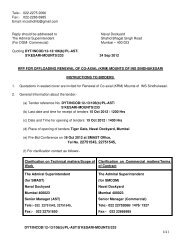

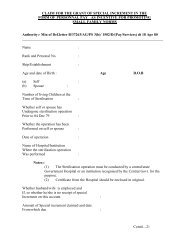
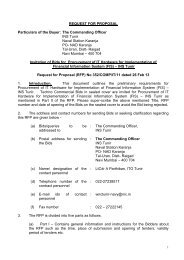
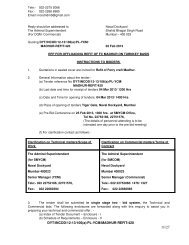
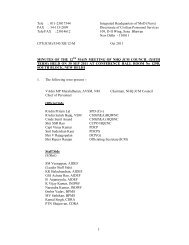

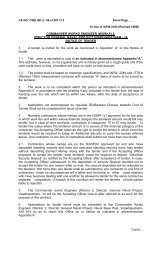
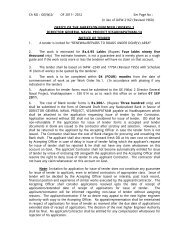

![DGNP[V] - Irfc-nausena.nic.in](https://img.yumpu.com/23509938/1/158x260/dgnpv-irfc-nausenanicin.jpg?quality=85)



